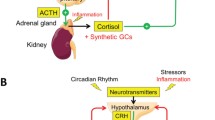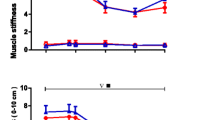Abstract
Rheumatoid arthritis (RA) is a disease associated with circadian disorders of steroid hormones or cytokine secretion which induce inflammatory, destructive and proliferative processes in the synovial joints. Angiogenesis plays an important role in RA, but circadian rhythms of the angiogenic mediator production, especially endothelial nitric oxide synthase (NOS3), are still unclear. NOS3 takes part in regulation of endothelial functions, inflammation, and bone remodeling process. Studying circadian rhythms of NOS3 production in RA patients will make an improvement in understanding the angiogenic—inflammatory pathways relevant to rheumatic diseases. The aim of the study was to test the hypothesis of a diurnal variation in circulating levels of NOS3 in RA patients. A cross-sectional monocentric pilot study of circadian variability of endothelial nitric oxide synthase in a Ukrainian population was conducted between March and July 2017. We examined 36 RA patients (100% women) and 34 age-matched healthy women without joint diseases and autoimmune diseases (control). Blood samples were collected four times per day (at 08:00; 14:00; 20:00 and 02:00) for two consecutive days. Serum NOS3 concentration was measured by ELISA (Cloud-Clone Corp kit). The study was conducted in compliance with bioethical standards. The SPSS22 software package was used for statistical processing of the results. A diurnal variation in circulating levels of NOS3 in healthy women was established, with peak values appearing in the evening and acrophase at 20:00, and low values in the morning, with batiphase at 08:00. In patients with RA serum, NOS3 levels were substantially decreased throughout the day compared to the control. In RA patients, a diurnal variation in circulating levels of NOS3 was also established. However, the variability of NOS3 production was higher in RA patients than in the control group. For example, in RA patients the difference between morning/evening values of NOS3 was 1.3 times higher (p < 0.05) than in the control. Negative correlations were found between the morning NOS3 levels and RA activity markers such as DAS28 and the number of tender and swollen joints. The diurnal variation in circulating levels of NOS3 in women with RA as well as in healthy women was found. However, in RA patients, a decrease in NOS3 production was observed, especially in the morning, which was associated with an increase in the disease activity. Thus, the circadian rhythm of circulating NOS3 can be opposite to the circadian rhythm of secretion of main inflammatory regulators in RA.

Similar content being viewed by others
References
Kouri V, Olkkonen J, Kaivosoja E, Ainola M, Juhila J, Hovatta I, Konttinen Y, Mandelin J (2013) Circadian timekeeping is disturbed in rheumatoid arthritis at molecular level. PLoS ONE 8(1):e54049
Olkkonen J, Kouri V, Kuusela E, Ainola M, Nordström D, Eklund K, Mandelin J (2017) DEC2 blocks the effect of the ARNTL2/NPAS2 dimer on the expression of PER3 and DBP. J Circadian Rhythms 15(1):6
Cutolo M (2016) Glucocorticoids and chronotherapy in rheumatoid arthritis. RMD Open 2:e000203. https://doi.org/10.1136/rmdopen-2015-000203
To H (2016) Chronotherapy for rheumatoid arthritis: current perspectives. ChronoPhysiol Ther 6:47–53
Jensen LD, Gyllenhaal C, Block K (2014) Circadian angiogenesis. BioMol Concepts 5(3):245–256. https://doi.org/10.1515/bmc-2014-0009
Nakagawa T, Sato W, Kosugi T, Johnson RJ (2013) Uncoupling of VEGF with endothelial NO as a potential mechanism for abnormal angiogenesis in the diabetic nephropathy. J Diabetes Res. https://doi.org/10.1155/2013/184539
Kunieda T, Minamino T, Miura K, Katsuno T, Tateno K, Miyauchi H, Kaneko S, Bradfield C, FitzGerald G, Komuro I (2008) Reduced nitric oxide causes age-associated impairment of circadian rhythmicity. Circ Res 102(5):607–614
Anea C, Cheng B, Sharma S, Kumar S, Caldwell R, Yao L, Ali M, Merloiu A, Stepp D, Black S, Fulton D, Rudic R (2012) Increased superoxide and endothelial NO synthase uncoupling in blood vessels of Bmal1-knockout mice. Circ Res 111(9):1157–1165
Cho K, Demissie S, Dupuis J, Cupples L, Kathiresan S, Beck T, Karasik D, Kiel D (2008) Polymorphisms in the endothelial nitric oxide synthase gene and bone density/ultrasound and geometry in humans. Bone 42(1):53–60
Yan L, Silver R (2016) Neuroendocrine underpinnings of sex differences in circadian timing systems. J Steroid Biochem Mol Biol 160:118–126. https://doi.org/10.1016/j.jsbmb.2015.10.007
Tasolar H, Eyyupkoca F, Akturk E, Karakus Y, Cansel M, Yagmur J, Ozyalin F, Altun B, Pekdemir H (2013) Endothelial nitric oxide synthase levels and their response to exercise in patients with slow coronary flow. Cardiovasc J Afr 24(9):355–359
Denesyuk VI, Denesyuk OV, Muzyka NO (2016) The remodeling of left atrium and vasodilation factors changes in ischemic heart failure. Int J Med Med Res 2(2):5–9
Aletaha D, Neogi T, Silman AJ et al (2010) 2010 Rheumatoid arthritis classification criteria: an American College of Rheumatology/European League Against Rheumatism collaborative initiative. Ann Rheum Dis 69:1580–1588
Denesyuk V, Muzyka N (2017) The influence of the additional usage of l-arginine on the factors of vasodilation and the clinical data, complicated with cardiac decompensation with reduced and preserved fracture of the left ventricle that patients with stable coronary heart disease have. Asian J Sci Technol 8(4):4689–4692
Vladymyrov OV, Tofan NI (2003) The L-arginine/NO system participation in cardiovascular diseases prevention and treatment in pregnant women. Fiziol zhurn49(2):73–78.
Shao G, Zhang S, Nie J, Li J, Tong J (2017) Effects of melatonin on mechanisms involved in hypertension using human umbilical vein endothelial cells. J Toxicol Environ Health Part A 80(23–24):1342–1348. https://doi.org/10.1080/15287394.2017.1384171
Cutolo M, Villaggio B, Candido F et al (1999) Melatonin influences interleukin-12 and nitric oxide production by primary cultures of rheumatoid synovial macrophages and THP-1 cells. Ann N Y Acad Sci 876:246–254
Liu Y, Mladinov D, Pietrusz JL et al (2009) Glucocorticoid response elements and 11 beta-hydroxysteroid dehydrogenases in the regulation of endothelial nitric oxide synthase expression. Cardiovasc Res 81(1):140–147. https://doi.org/10.1093/cvr/cvn231
Sulli A, Maestroni GJ, Villaggio B et al (2002) Melatonin serum levels in rheumatoid arthritis. Ann N Y Acad Sci 966:276–283
Zoli A, Lizzio MM, Ferlisi EM, Massafra V, Mirone L, Barini A et al (2002) ACTH, cortisol and prolactin in active rheumatoid arthritis. Clin Rheumatol 21(4):289–293
Searles CD (2006) Transcriptional and posttranscriptional regulation of endothelial nitric oxide synthase expression. Am J Physiol Cell Physiol 291:803–816
Lee KS, Kim J, Kwak SN et al (2014) Functional role of NF-κB in expression of human endothelial nitric oxide synthase. Biochem Biophys Res Commun 448(1):101–107
Sen A, Most P, Peppel K (2014) Induction of microRNA-138 by pro-inflammatory cytokines causes endothelial cell dysfunction. FEBS Lett 588(6):906–914
Anderson H, Rahmutula D, Gardner D (2003) Tumor necrosis factor-α inhibits endothelial nitric-oxide synthase gene promoter activity in bovine aortic endothelial cells. J Biol Chem 279(2):963–969
Neumann P, Gertzberg N, Johnson A (2004) TNF-α induces a decrease in eNOS promoter activity. Am J Physiol Lung Cell Mol Physiol 286(2):L452–L459
Goodwin B, Pendleton L, Levy M, Solomonson L, Eichler D (2007) Tumor necrosis factor-α reduces argininosuccinate synthase expression and nitric oxide production in aortic endothelial cells. Am J Physiol Heart Circ Physiol 293(2):H1115–H1121
González-Fernández F, Jiménez A, López-Blaya A, Velasco S, Arriero M, Celdrán Á, Rico L, Farré J, Casado S, López-Farré A (2001) Cerivastatin prevents tumor necrosis factor-α-induced downregulation of endothelial nitric oxide synthase: role of endothelial cytosolic proteins. Atherosclerosis 155(1):61–70
Barsacchi R, Perrotta C, Bulotta S, Moncada S, Borgese N, Clementi E (2003) Activation of endothelial nitric-oxide synthase by tumor necrosis factor-α: a novel pathway involving sequential activation of neutral sphingomyelinase, phosphatidylinositol-3′ kinase, and Akt. Mol Pharmacol 63(4):886–895
Sokka T, Toloza S, Cutolo M et al (2009) (QUEST-RA Group) Women, men, and rheumatoid arthritis: analyses of disease activity, disease characteristics, and treatments in the QUEST-RA Study. Arthritis Res Ther 11:R7. https://doi.org/10.1186/ar2591
Acknowledgements
External language editing support was provided by a translation agency ‘Visa’.
Funding
None.
Author information
Authors and Affiliations
Contributions
All authors approved the final manuscript as submitted and agree to be accountable for all aspects of the work, and took full responsibility for the integrity of the study. KZ wrote the initial version of the manuscript, collected and interpreted the data and edited the manuscript. MS and NZ supervised the research, took part in interpretation of the data and wrote the manuscript.
Corresponding author
Ethics declarations
Conflict of interest
None.
Additional information
Publisher's Note
Springer Nature remains neutral with regard to jurisdictional claims in published maps and institutional affiliations.
Rights and permissions
About this article
Cite this article
Zaichko, K., Stanislavchuk, M. & Zaichko, N. Circadian fluctuations of endothelial nitric oxide synthase activity in females with rheumatoid arthritis: a pilot study. Rheumatol Int 40, 549–554 (2020). https://doi.org/10.1007/s00296-020-04525-4
Received:
Accepted:
Published:
Issue Date:
DOI: https://doi.org/10.1007/s00296-020-04525-4




